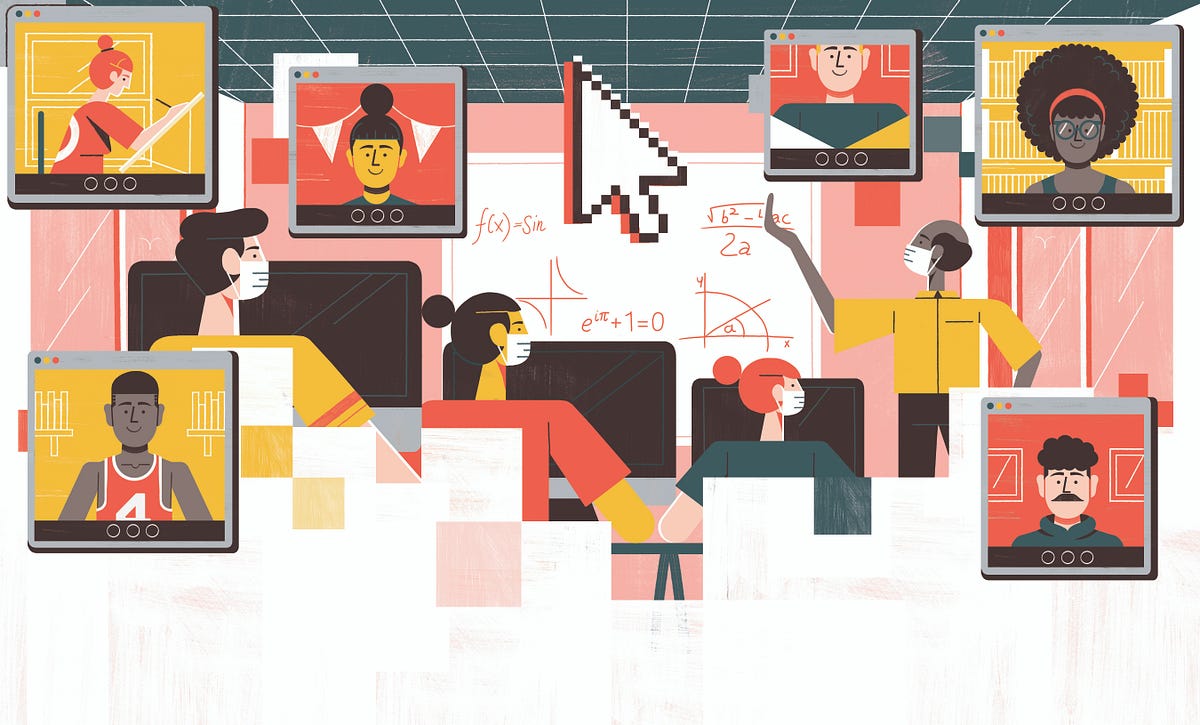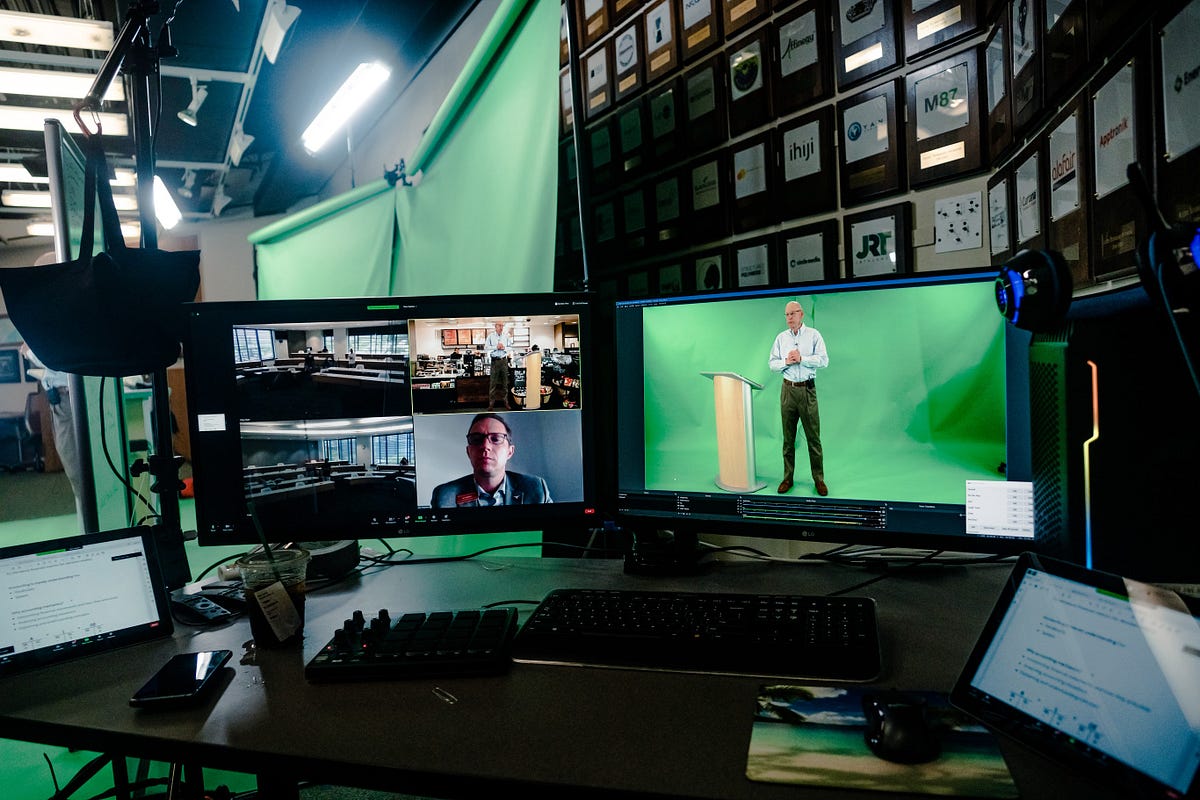A Learning Revolution
The McCombs response: Necessity closes school’s classrooms and gives birth to innovations
By Matt W. Turner

When the COVID-19 pandemic showed up at The University of Texas at Austin in March — on Friday the 13th, no less — change was swift. The campus shuttered. Spring break was extended. And professors had two weeks to become proficient in online teaching.
It’s not that online learning was anything new. The McCombs School of Business’ M.S. in Technology Commercialization program had been livestreaming courses for years. The global nonprofit EdX, founded by Harvard University and the Massachusetts Institute of Technology, had offered hundreds of online classes, including UT courses, since 2012. But for the overwhelming majority of classes at Texas and across the nation, what was seen at best as the bugbear of the Digital Age, and at worst the bête noire of education, was suddenly the new normal. Many professors had never taught an online class. A revolution in instructional innovation was at hand, and it would change not only how we teach, but what we teach, and even to whom we teach it.
Several years ago, with foresight, then-dean and now UT Austin President Jay Hartzell appointed Prabhudev Konana, Distinguished Teaching Professor and the William H. Seay Centennial Professor of Business, as McCombs’ first associate dean for instructional innovation.
As the pandemic raged and in-class learning was halted for the spring and summer semesters, Konana brought together his colleagues and media services staff to create 30 workshops on mastering Zoom and the best practices for online instruction. Some of these were attended by as many as 200 McCombs faculty members, who joined in a common cause to share their experiences and practice with one another.
McCombs’ instructional videos were posted online and became a go-to for faculty members. Media staffers worked nights and weekends, upgrading 60 classrooms to enable hybrid classes for the fall (part in-person, part remote), improving cameras, projectors, and sound systems, while providing faculty members with iPads or touch-screen laptops as needed.
Remarkably, faculty members now report that online education can increase student engagement. “Flipping the classroom,” for instance, is a now commonplace teaching strategy whereby teachers record lectures, audio tapes, and activities on the course’s fundamental concepts, so students can study these at their own pace. Konana points to studies that show students, especially those in the bottom 50%, are learning much better this way than they would in a traditional lecture hall.
Keeping fundamentals at home frees up class time for interpretation and creativity.
The livestreamed classes still include activities, break-out discussions, and interviews with experts, but now teachers are also using instant polling, iClickers, and peer grading to keep students on their toes and keep instructors apprised of who needs extra attention. And because online meetings are so easy, teachers are offering virtual discussion sessions, exam preps, and even lunchtime gatherings. Finance Professor Keith Brown, echoing the sentiments of many McCombs faculty members, exclaims, “I’m genuinely astonished that students, having ignored in-person office hours for decades, are showing up for virtual ones!”
At the program level, online education allows students to pursue electives and certificates that would otherwise be impossible given faculty constraints. And online classes are a boon for people who are too busy or who cannot afford to quit their jobs. Business executives, parents at home with children, military personnel, international applicants — the list is long — now have unprecedented access to furthering their education.
What will be interesting, says Konana, who next year will become dean of the Robert H. Smith School of Business at the University of Maryland-College Park, is to see what we retain of all this post-COVID-19.
“The crisis brought all of us into the 21st century, and many of these new tools and techniques are here to stay,” says Konana.

Innovation: Teaching “Live” by Hologram
Instructor: Steve Limberg, PricewaterhouseCoopers Centennial Professor, Accounting
Class: Business Administration 384T: Financial Accounting (Executive MBA Program)
Size: 43 students (70% in person, 30% online)
Impetus: To take the screen out of the online learning experience so students and teachers feel more engaged.
How it works: McCombs contracted with Austin startup Contextual Concept Group to create a new immersive video solution. Delivering the class from an off-campus television studio, Limberg is streamed live as a high-resolution, 6-foot hologram to the socially distanced classroom and as a full-body tile to students online via Zoom.
The technology, known as Recourse, allows Limberg to interact with both the physical classroom and the virtual classroom in real time. Students, who appear in the studio on three large screens, can also ask questions and engage with their professor just as if they were in a classroom with him. The tech manager (or “producer”) can even add sound effects, music and videos, and can assist with panel discussions involving visitors and industry experts.
How students benefit: The experience approximates live teaching because the students behold their teacher in 3D form, while the teacher notices their gestures and nuanced expressions, whether it be raising a hand or an eyebrow or just nodding. As a result, “It really is very much like being right here in the classroom with the students,” Limberg says. He adds that by leaving all the operational details to the producer, “I can focus 100% of my energy on teaching. When I enter the studio, it’s showtime!”
The technology allows Limberg to interact with both the physical classroom and the virtual classroom in real time.

Innovation: Improved technology, In-class Polling, Virtual Lunches
Instructor: Sandy Leeds, Distinguished Senior Lecturer, Finance
Classes: BA 385 Financial Management for M.S. in Marketing students; FIN 371M Money and Capital Markets for BBA students
Size: 60–65 students
Impetus: How does a teacher conduct an engaging, vibrant class when students are reduced to a series of tiny pictures? And how can students develop any kind of real relationship with their instructor?
How it works: Leeds says it’s hard to feel like a real teacher when seated in front of a laptop. So, he ditched the usual setup for two large TV monitors and a good video camera. That way, he can lecture while standing, simultaneously viewing the slide deck he is discussing on one screen and seeing a good-sized video feed of his 60-plus students on the other.
Leeds makes daily use of Zoom’s in-class polling feature. For instance, he may ask for a solution to a time value of money problem. Simply taking the poll live in class yields a number of benefits: All students are forced into active engagement; they instantly see whether they are grasping the concepts; they know where they stand vis-à-vis their peers; and the professor can identify who needs follow-up help. Compare that scenario with the old-school question at the chalkboard, with a couple of raised hands and half the class tuned out, and the advantages are obvious.
To further increase student engagement, Leeds sets up virtual “lunches” in which six students can sign up to attend on a given day. Everyone dines in the comfort of their homes and gets personal time with their professor in a relaxed setting at no cost. The ease of such meetings provides student access to teachers as never before. Like many other faculty members, Leeds finds his virtual office hours far better attended than “real” ones. In fact, student engagement has gotten so strong that Leeds sometimes finds the need to set boundaries.
How students benefit: Student engagement through polling, lunches, and office hours is greatly enhanced. As one M.S. in Marketing student told Leeds, “I’d never gotten this much attention from my professors before going online.” Simple changes in technology pay off for a more dynamic classroom experience.

Innovation: Flipping the Class and Livestreaming
Instructor: James Scott, Professor, IROM
Classes: Statistics 301: Introduction to Data Science (online only, new starting fall 2020)
Size: 530
Impetus: In order to tackle the increasingly large and complex data sets of the Information Age, data science today requires a solid grounding in statistical tools and software skills.
How it works: “Flipping the class” means students learn the rote and formulaic foundational material outside of class, freeing up class time for higher-order, qualitative thinking and problem solving. Scott, who has been using this method for some time, has amassed a large library of class materials of taped lectures, videos, and software walkthroughs that students can peruse at their own pace. Using technology to teach basic material in this fashion, Scott says, is as effective, if not more effective, as trying to convey the same material in person. Classroom time then becomes a venue for doing open-ended, data analysis problems — real data science. This is where students are at the edge of their abilities, their “reach,” as Scott puts it, and precisely where instructors can be most helpful.
This fall, Stats 301 is being streamed live from a soundstage, and enrolled students watch the broadcast simultaneously online. Such “synchronous learning” also involves live chat rooms, which play a big part in the class. Students are given real problems that they work on individually while also discussing matters with their partners. A team of teaching assistants monitors the chat rooms to identify common issues that the instructor can then address.
How students benefit: Flipping the class is a more efficient use of time for both teacher and student. Students stay more motivated. And teachers can focus more on modern computation and creative visualization, as well as equip students with more sophisticated tools from machine learning and artificial intelligence.
Online learning creates scale, which in itself brings two advantages. First, a large class size allows teachers to collect rich data sets about the students themselves, which can then be turned into statistical problems that students are more motivated to tackle. Second, a large enrollment allows faculty members to practice what they teach: by running micro-experiments in class on teaching techniques, the instructor can see firsthand which are most effective and therefore most beneficial for students.

Innovation: Online Office Hours, Review Sessions and Exam Prep
Instructor: Keith Brown, University Distinguished Teaching Professor and Fayez Sarofim Fellow, Finance
Classes: FIN 297.1 Investment Theory and Practice for MBA students
Size: 22 students (in each of three sections)
Impetus: Online learning lacks real, face-to-face presence. As Brown puts it, “For the first time ever, there will be students in my class whom I’ll never meet in person.”
How it works: Brown simply sets up standard weekly office hours as Zoom meetings, review sessions, and exam prep hours. All a student has to do to attend is click a button.
How students benefit: Increased engagement. Students show up to office hours in droves. Brown was astonished. “In an average semester, the number of students who used to show up for my office hours was zero. Since offering these meetings online, students come to every single one and often stay until the end. In fact, we often go beyond time,” he says.
Like many of his colleagues with similar experiences, Brown was taken aback. No one would have guessed that having to go to a professor’s office was such an impediment, but it obviously was. One MBA student told Brown that “he should feel honored, since he was the only professor whose office hour he’d ever attended in his life.”
Brown notes similar attendance for group work, review sessions, and special preparation for exams. Students appreciate the extra engagement and simplicity of connection, and in many ways get more high-quality time from the professor and from one another than they would otherwise.
Online meetings are a game changer. After the COVID-19 crisis is over, Brown says he’s still going to do these meetings online, even if they are also offered face to face: “It’s just a no-brainer.”

Innovation: Self-paced Instruction
Instructor: Katie Gray, Senior Lecturer, IROM
Class: M.S. Online Programming (Pilot Program) through University Extension
Size: 15 students
Impetus: Strong applicants to the MSBA and MSITM programs are sometimes denied admission simply for lacking a basic programming class in their academic backgrounds.
How it works: This self-paced course went live March 3. “There are some students who have a background and some who don’t, so it makes sense to create this class as self-paced so they can figure it out at their own speed,” Gray says.
How students benefit: Instead of being denied admission because of a missing skills class, students with otherwise excellent credentials can remedy their shortcomings quickly and effortlessly without having to postpone admission for a whole year to take a traditional class. Increased overall enrollments are a win-win for applicants and schools alike. “This is the future of what education will look like and how students want to be taught,” Gray says.
Research shows that overall students are reading less than in the past, but that they will retain more during class if they’ve read materials beforehand rather than after. Students who read before class are better primed for learning and have a better overall experience. — Heidi Toprac

Innovation: McGraw-Hill “Connect” and iClickers
Instructor: Heidi Toprac, Director of Undergraduate Internship Program
Class: Finance 357: Business Finance
Size: 50 students
Impetus: “Research shows that overall students are reading less than in the past, but that they will retain more during class if they’ve read materials beforehand rather than after. Students who read before class are better primed for learning and have a better overall experience,” Toprac says.
How it works: The class’s textbook has an online feature, Connect, which allows the students to do their homework online at their own pace as long as they meet the assigned deadline. As the students read, the textbook sporadically will present a question. If a student gets the question correct, he or she can continue reading; if not, the textbook sends the student back a couple of pages and requires rereading of the material. How students benefit: “Some students prefer to use technology to engage with the material,” Toprac says. “We’re trying to meet the students where they are and help them succeed using whatever possible tools we can.”
Other innovations: Each student in Toprac’s classes also uses an iClicker, a remote device that allows a student to anonymously respond to questions the instructor poses in class.
How it works: During every class, students have a pop quiz on conceptual questions. This allows students to practice retrieving the material and responding to the questions.
How students benefit: According to Toprac, the more students practice testing themselves, the better they will perform on tests.
This article appeared in the winter 2020 issue of McCombs magazine. Click on the link to see the full issue.


